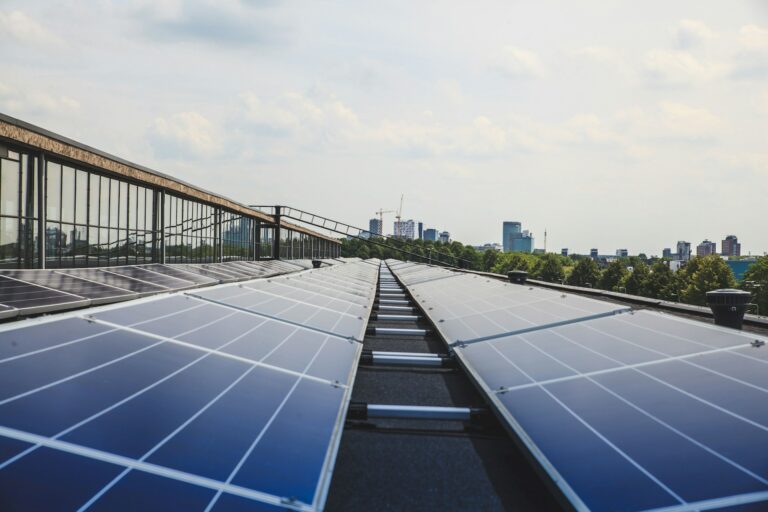Urban planners envision cities where progress and sustainability go hand in hand. They envision streets lined with trees, buildings covered in greenery, and energy that fuels growth without leaving behind environmental damage. The environmental impact of solar energy in urban planning plays a crucial role in making this vision a reality. No longer a niche concept, solar power is essential to the urban puzzle, transforming rooftops, public spaces, and streetlights into clean energy hubs.
Unlike fossil fuels, which scar landscapes and pollute the air, solar energy works quietly and seamlessly into city life. But solar power is not just about slapping panels onto rooftops and hoping for the best. It requires strategy, investment, and innovation. When done right, it reduces pollution, increases energy independence, and even lowers urban temperatures.
How Solar Energy and the Environment Coexist
Solar panels are silent and efficient, generating electricity without the pollutants associated with traditional power sources. According to the U.S. Energy Information Administration (EIA), solar energy significantly reduces carbon dioxide emissions. Unlike coal or natural gas plants, solar installations do not require water for cooling, avoiding the thermal pollution that stresses urban water supplies.
Air quality is another crucial benefit. Burning fossil fuels releases sulfur dioxide, nitrogen oxides, and particulate matter, all contributing to respiratory issues. Solar panels eliminate this problem. Cities with widespread solar adoption enjoy cleaner air, making life easier for those with asthma and other lung conditions.
But solar is not entirely impact-free. Manufacturing panels requires mining materials such as silicon, silver, and lithium. This process consumes energy and produces waste. However, the environmental footprint of making and installing solar panels is far smaller than the lifetime emissions of coal or natural gas. Over time, solar power repays its initial environmental cost many times over.
Solar in the City: A Practical Shift
Busy urban environments present unique challenges for solar energy. Unlike wide-open rural spaces, cities are crowded and full of high-rise buildings that cast long shadows. Not every rooftop is suitable for solar panels, and weather conditions affect output.
However, cities also provide vast untapped solar potential. Parking lots, transit stations, and even abandoned industrial sites can host solar panels. In some cases, buildings generate more electricity than they use, feeding surplus energy back into the grid. This decentralization reduces dependence on fossil fuel power plants and strengthens energy resilience.
Urban solar farms—clusters of solar panels installed in underutilized spaces—are becoming increasingly popular. These projects bring clean energy to communities that may not have access to solar panels on their rooftops. Combined with energy storage systems, urban solar farms help smooth out fluctuations in power generation, ensuring electricity is available even when the sun is not shining.
Smart Cities, Smarter Energy
A city never sleeps—its streets, transit systems, and public services demand continuous power long after the sun sets. Innovative solar-powered solutions are transforming urban energy infrastructure to meet this challenge sustainably. By integrating solar energy with intelligent grid management and energy storage, cities can enhance reliability, efficiency, and environmental conservation.
At the forefront of this movement is EnGoPlanet, a leading provider of smart solar solutions for urban environments. Specializing in solar-powered streetlights, this company reduces dependency on traditional power grids while cutting operational costs and carbon emissions. Their smart lighting systems dynamically adjust brightness based on pedestrian and vehicle activity, optimizing energy use without compromising safety. In addition, their solar benches are equipped with charging ports and Wi-Fi hotspots, which make public spaces more functional while running entirely on renewable energy.
Beyond street lighting, entire neighborhoods are adopting solar microgrids—self-sustaining energy networks that generate, store, and distribute their power. These systems enhance resilience, ensuring essential services such as hospitals, emergency centers, and public transit hubs remain operational even during grid failures. By leveraging cutting-edge solar innovations, cities reduce their carbon footprint and pave the way for smarter, cleaner, and more sustainable urban living.
Solar Energy in Urban Planning: Reducing Urban Heat Islands
Cities are significantly warmer than their rural surroundings, a phenomenon known as the urban heat island effect. Asphalt, concrete, and steel absorb heat throughout the day and slowly release it at night, raising temperatures and increasing demand for air conditioning and energy consumption.
Solar panels provide a partial solution. By covering rooftops with reflective solar panels, cities can reduce the heat buildings absorb. A well-placed solar installation generates clean electricity and lowers cooling costs.
Some cities are taking things further by integrating solar technology with green roofs. These rooftops combine vegetation with solar panels, creating micro-ecosystems that insulate buildings while producing energy. The result? Cooler urban spaces, lower electricity bills, and improved air quality.
The Challenges of Solar Integration
Despite its many advantages, solar energy in urban planning faces hurdles. One of the biggest is infrastructure. Cities built decades ago were not designed with solar power in mind. Retrofitting old buildings for solar panels can be expensive, and not every roof is suitable for installation.
Policy and regulation also play a role. In some cities, zoning laws and historic preservation rules limit the placement of solar panels. Utility companies can also be resistant to widespread solar adoption, as it disrupts traditional energy distribution models.
Storage remains another challenge. Solar power is most abundant during daylight hours, but energy demand often peaks in the evening. Without adequate storage solutions, much of this energy goes unused. Advances in battery technology are helping bridge this gap, but large-scale storage remains costly.
The Long Game: Waste and Lifespan
Solar panels do not last forever. Most last 25 to 30 years before their efficiency declines. As cities adopt solar energy on a large scale, they must also plan to dispose of and recycle aging panels.
Recycling efforts are still in their early stages, but progress is being made. Researchers are developing methods to recover valuable materials from old panels, ensuring they do not become an environmental burden. In the coming years, we can expect more efficient recycling processes to emerge, making solar energy even more sustainable.
Looking Ahead
Cities are evolving, and so is the way they consume energy. Using solar energy in urban planning is not just about reducing emissions or cutting electricity costs – it is about reimagining how energy integrates into the urban landscape.
Cities are finding new ways to harness the sun’s power, from solar-powered transit systems to energy-efficient street lighting. The transition is challenging, but the long-term benefits far outweigh the obstacles.
A city powered by solar energy is not just a dream but a necessity. As technology advances and infrastructure adapts, urban centers will continue shifting toward cleaner, more efficient energy solutions. The future is not just bright; it is solar-powered.





